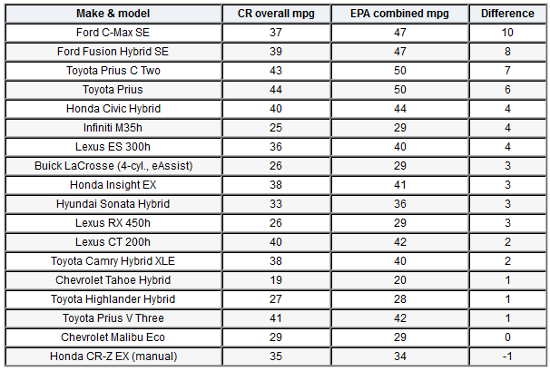Tests Show Ford Fusion, C-Max Hybrid Are Not Getting Close To 47 MPG
Watch ads for the 2013 Ford Fusion Hybrid sedan or its C-Max Hybrid wagon and you’ll hear that the vehicles get 47 miles per gallon (highway and city combined), which sounds awfully nice considering the cost of gasoline. But real-road tests of these cars don’t seem to back those numbers up.
In fact, tests by our car-loving cousins at Consumer Reports found that C-Max only got around 37 mpg (city/highway combined). While that is a very good number — second in its class to the Prius V’s 41 mpg — it’s only 79% of the mpg touted by Ford.
The Fusion fared slightly better, with a combined 39 mpg, around 83% of what Ford claims. On the highway, the Fusion did get as efficient as 41 mpg in the CR tests, though its city number was down at 35 mpg. The C-Max came in with more consistent numbers — 35 mpg city, 38 mpg highway.
According to CR, more than 80% of the vehicles it has tested for gas mileage are within 2 mpg of the EPA-estimated numbers given by the manufacturers. See the chart below showing the real-world fuel economy numbers for a range of vehicles.
Before the tests on the new Fusion and C-Max, the largest discrepancy between the EPA numbers and real-world tests had been 7 mpg for the Toyota Prius C and 6 mpg for the Prius hatchback.
“Most buyers won’t get anything near 47 mpg in the real world,” says Jake Fisher, Consumer Reports’ director of auto testing. “Even though these two Ford hybrids are very efficient, this big discrepancy may leave customers disappointed.”
In response to our results, a Ford representative said in an email, “Early C-Max Hybrid and Fusion Hybrid customers praise the vehicles and report a range of fuel economy figures, including some reports above 47 mpg. This reinforces the fact that driving styles, driving conditions, and other factors can cause mileage to vary.”
This article explains the various ways Consumer Reports puts cars through the wringer, but in short, after breaking in each vehicle for 2,000 miles, testers run each vehicle through simulations of city driving conditions on the test track, while highway data is achieved by driving along a specific stretch of a nearby interstate.
Meanwhile, most EPA fuel-economy estimates certified by testers for the actual manufacturer. The EPA does later spot-check about 15% of cars with its own tests.
In November, the EPA spanked Hyundai pretty hard for overstating their fuel-economy estimates. The car maker will now be paying out millions of dollars in refunds.
Want more consumer news? Visit our parent organization, Consumer Reports, for the latest on scams, recalls, and other consumer issues.


